 Credit: Nvidia
Credit: Nvidia
Nvidia revealed its long-awaited GeForce RTX 30-series graphics cards on Tuesday, and frankly, they look ferocious. The company claims these GPUs represent Nvidia’s “greatest generational leap ever,” and on paper, the GeForce RTX 3070, GeForce RTX 3080, and GeForce RTX 3090 certainly look to live up to those claims.
Our GeForce RTX 30-series announcement coverage and RTX 30-series vs. RTX 20-series spec comparison wade deep into the sort of nitty-gritty details that nerds love. But if you’re a gamer who just wants a high-level tl;dr view of what matters with these graphics cards, read on.
Here are five things you need to know about Nvidia’s cutting-edge GeForce RTX 30-series.
1. They should be smoking-fast
One of the biggest digs against the older GeForce RTX 20-series was that those GPUs didn’t provide enough performance uplift versus their predecessors. Nvidia listened. The company claims the $500 GeForce RTX 3070 will be faster than the former $1,200 GeForce RTX 2080 Ti flagship, and the $700 GeForce RTX 3080 will churn out frames at a much higher clip. As for the monstrous $1,400 GeForce RTX 3090, well, Nvidia didn’t get into many hard performance details other than to say it will be the first graphics card capable of playing games at 8K resolution. Holy moley.
Check out these Nvidia-supplied performance charts:
 Nvidia
Nvidia
An Nvidia-supplied comparison of how the GeForce RTX 30-series GPUs compare against the RTX 20-series in a variety of games.
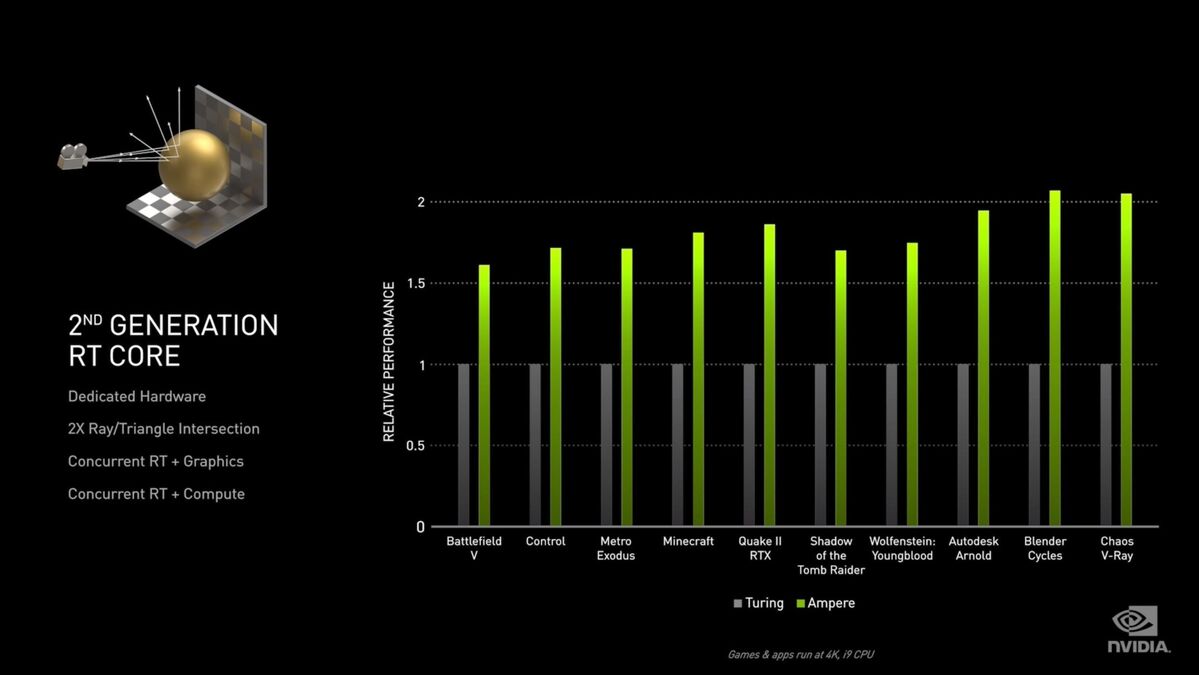 Nvidia
Nvidia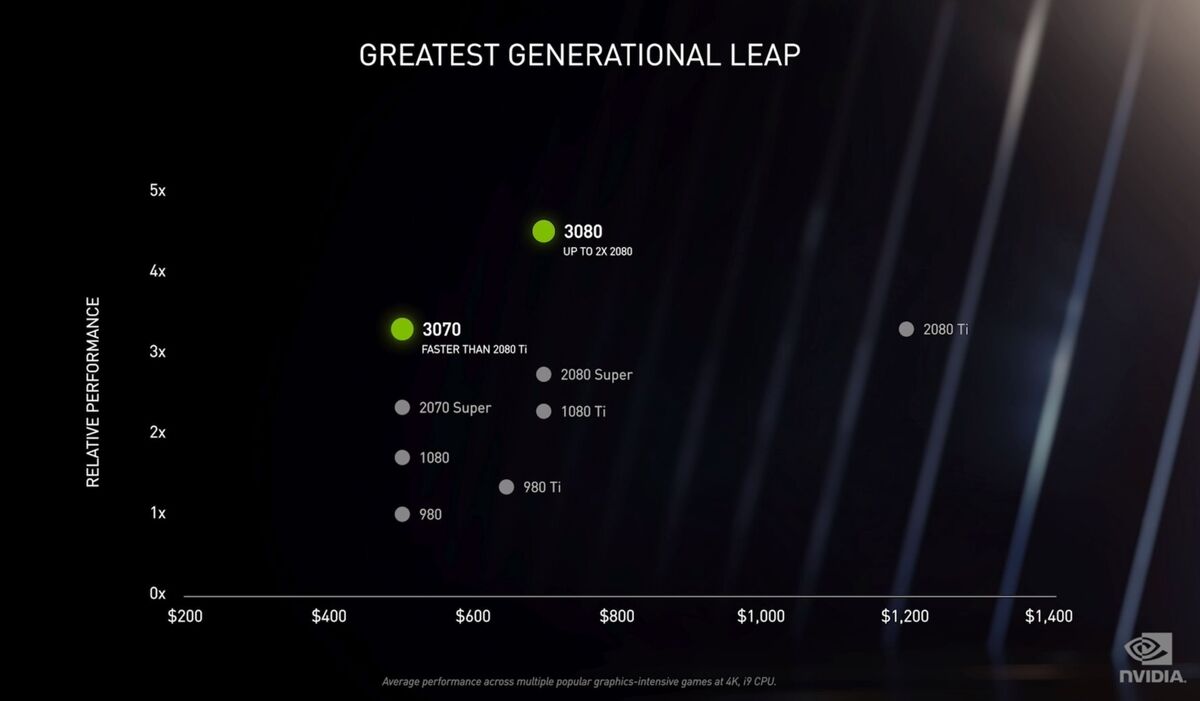 Nvidia
NvidiaAnd yes, the GeForce RTX 30-series should absolutely scream in games with RTX features like ray tracing and DLSS enabled. Nvidia says the revamped RT and tensor cores inside these “Ampere”-architecture GPUs will be 1.7X and 2.7X faster than their predecessors, respectively.
Of course, you want to wait for independent testing to verify Nvidia's lofty claims, but nevertheless: Giddy up.
2. The memory can make your games faster
The GeForce RTX 3080 and RTX 3090 pack cutting-edge GDDR6X memory, which promises to move data twice as fast as the GDDR6 memory found in the GeForce RTX 20-series. The 3090 comes packed with a whopping 24GB of it. That’s impressively ludicrous, but some new Nvidia technology aims to put that memory and the GeForce RTX 30-series’ PCIe 4.0 support to even better use: improving your game-loading times.
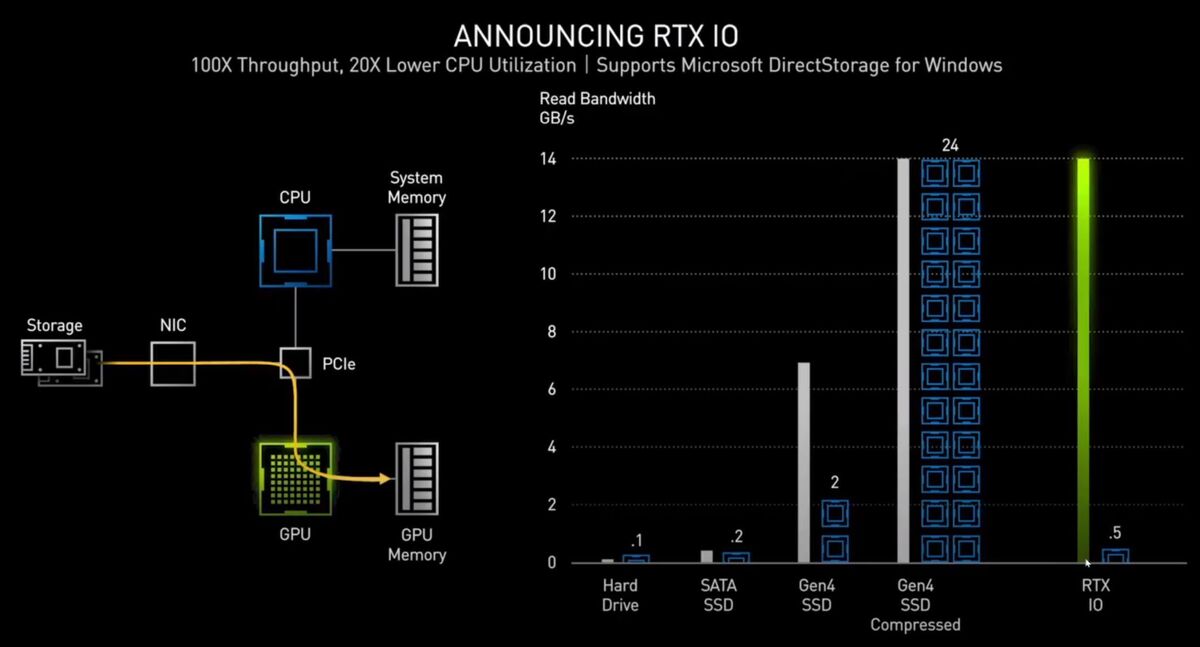 Nvidia
NvidiaCEO Jensen Huang didn’t go into much detail, but Nvidia’s RTX IO technology puts the speed of PCIe 4.0 storage to more efficient use, sending some loading and texture data over the PCIe 4.0 connection of the GeForce RTX 30-series GPUs to tap into their blazing-fast onboard memory--rather than routing all that information through the CPU first, where things could get bogged down. Games could load virtually instantaneously, Huang teased. Nvidia claims the technology offers 100X greater throughput with 20X lower CPU utilization than traditional methods.
Many questions remain—including whether it’ll just work, or if game developers will need to actively support it—but it’s reassuring to hear that RTX IO is built upon Microsoft’s DirectStorage API for Windows. You know how Microsoft and Sony keep talking up how fast the storage is in their next-gen consoles? DirectStorage underpins the speedy Velocity Architecture storage system in the Xbox Series X, too.
3. New cooler, new 12-pin, new power supply?
Generating all these frames isn’t free. The GeForce RTX 3080 draws 320W of power—even more than the previous-gen GeForce RTX 2080 Ti flagship, which sucked down 260W. And that beastly GeForce RTX 3090 is even hungrier, gobbling down 350W. Oof. You might need a new power supply to handle these graphics cards, though Nvidia says a 750W PSU should work just fine. Maybe don’t pair it with an overclocked Core i9-10900K, though.
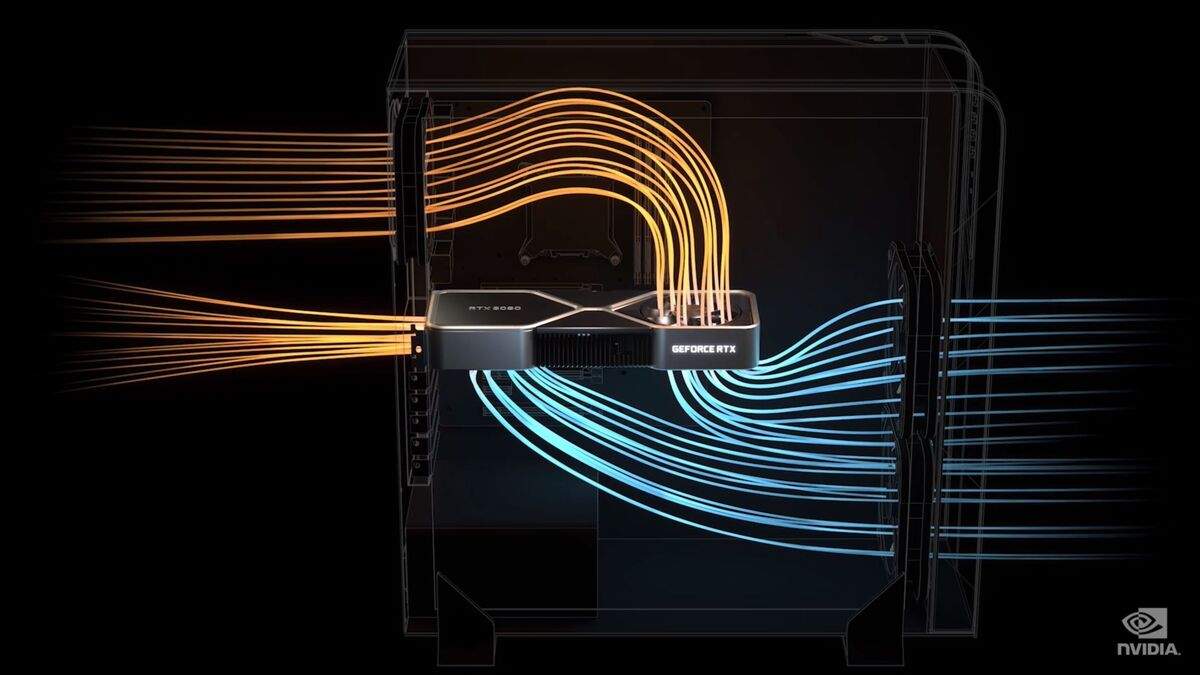 Nvidia
Nvidia
How the new cooler works.
Nvidia needed to re-engineer its entire design to make this work. The GeForce RTX 3080 and 3090 use a tiny new 12-pin connector that combines the power of dual 8-pin connectors into a single slot, so that they’ll fit on a new ultra-compact PCB inside the cards, which was needed to create a new cooling system with independent push/pull fans that tap your system’s rear case fans for additional thermal help. Phew.
Even with all that, Nvidia’s Founders Edition cards come rated for 93-degree Celsius operating temperatures, higher than the 89-degree maximum set by the older RTX 20-series GPUs. All that said, Huang said the new cooler on the GeForce RTX 3080 operates a full 30 degrees cooler than the prior-gen RTX Titan. Good stuff.
4. Adios, SLI
Multi-GPU configurations haven’t really been compelling (or very operational) for several graphics card generations now, thanks to a mixture of increasingly powerful GPUs and increasingly wonky game engine support. The GeForce GTX 10-series reduced SLI support to two graphics cards, down from four prior. The GeForce RTX 30-series all but eliminates it.
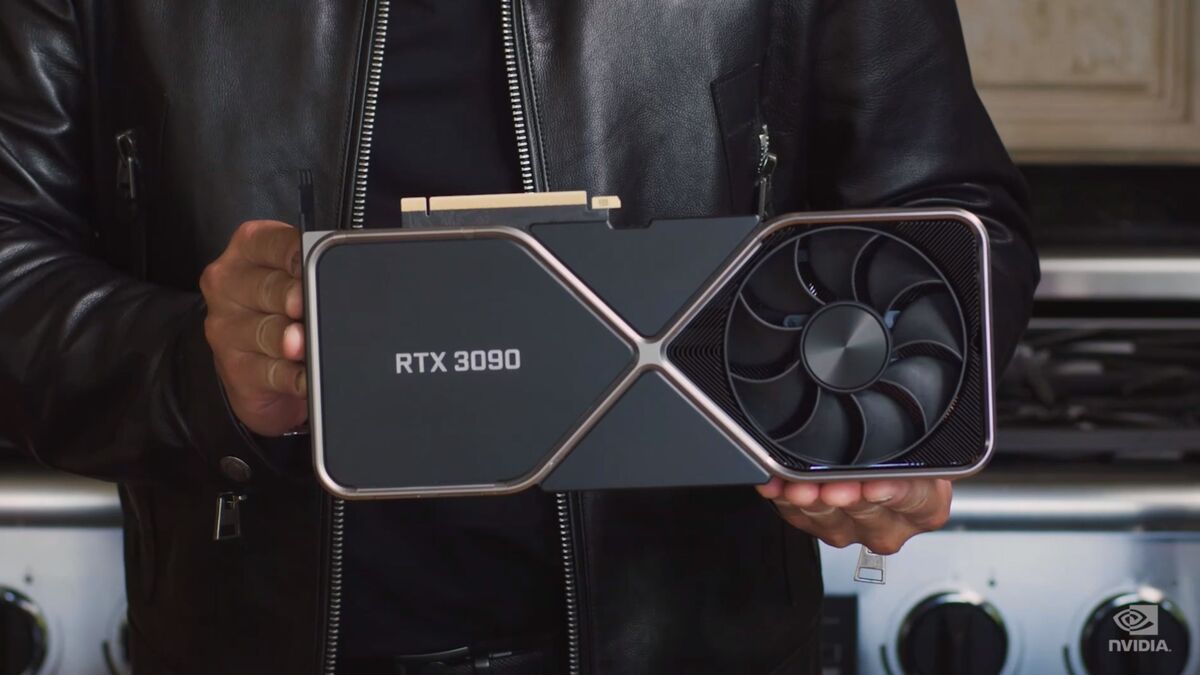 Nvidia
Nvidia
GeForce RTX 3090: The more you buy, the more SLI you save.
The $1,500 GeForce RTX 3090 "BFGPU" is the only card with an NVLink connector for SLI. Even the GeForce RTX 3080 that Nvidia called the 30-series flagship lacks it. It’s no big loss to most people, especially since these GPUs look ready to absolutely chew through frames at 1440p and 4K resolutions, but pour one out, price-is-no-object monster rig enthusiasts—unless you want to dump $3,000 into a twin 3090 rig for even better 8K gaming performance on a monster TV.
5. More than just hardware
Nvidia’s supporting the GeForce RTX 30-series launch with more than just the cards themselves.
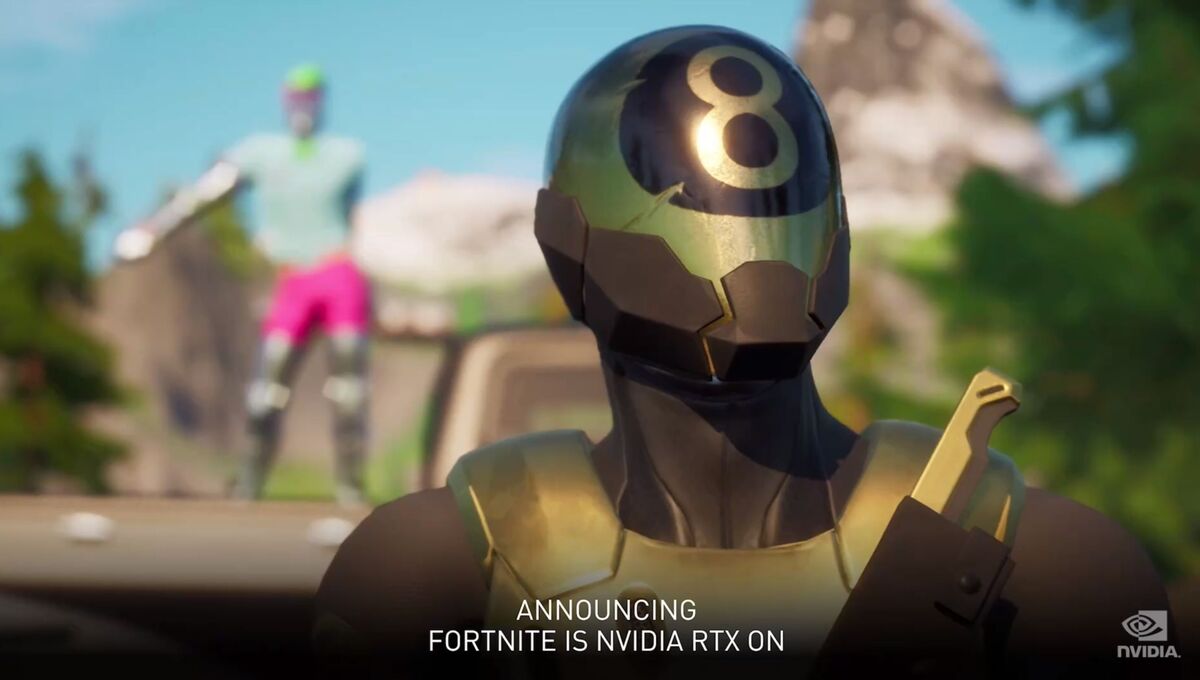 Nvidia
NvidiaWhile the RTX 20-series infamously launched without any ray traced games in tow, Nvidia’s RTX push for ray traced and DLSS games has been gaining steam for two years now. The company landed a titan for this release: Fortnite is getting ray-traced shadows and DLSS. With Minecraft rolling out ray tracing and DLSS earlier this year to glorious effect, the two most popular PC games in the world are firmly onboard the RTX bandwagon now.
That’s not all. Nvidia’s rolling out two new pieces of software to help you put the power of these new GPUs to greater use.
Nvidia Reflex is “a revolutionary suite of GPU, G-SYNC display, and software technologies that measure and reduce system latency in competitive games.” We’ll need to test it ourselves before drinking the Kool-Aid, of course, but Nvidia claims it can reduce click-to-display latency by up to 33 percent, or even a whopping 50 percent, which could give you a substantial edge over the competition in esports games where every millisecond matters.
Call of Duty Warzone, Valorant, Fortnite, and Destiny 2 will be among the first games to support Nvidia Reflex when it launches this month. It’ll also be coming to Call of Duty: Modern Warfare, Call of Duty: Black Ops Cold War, and Apex: Legends.
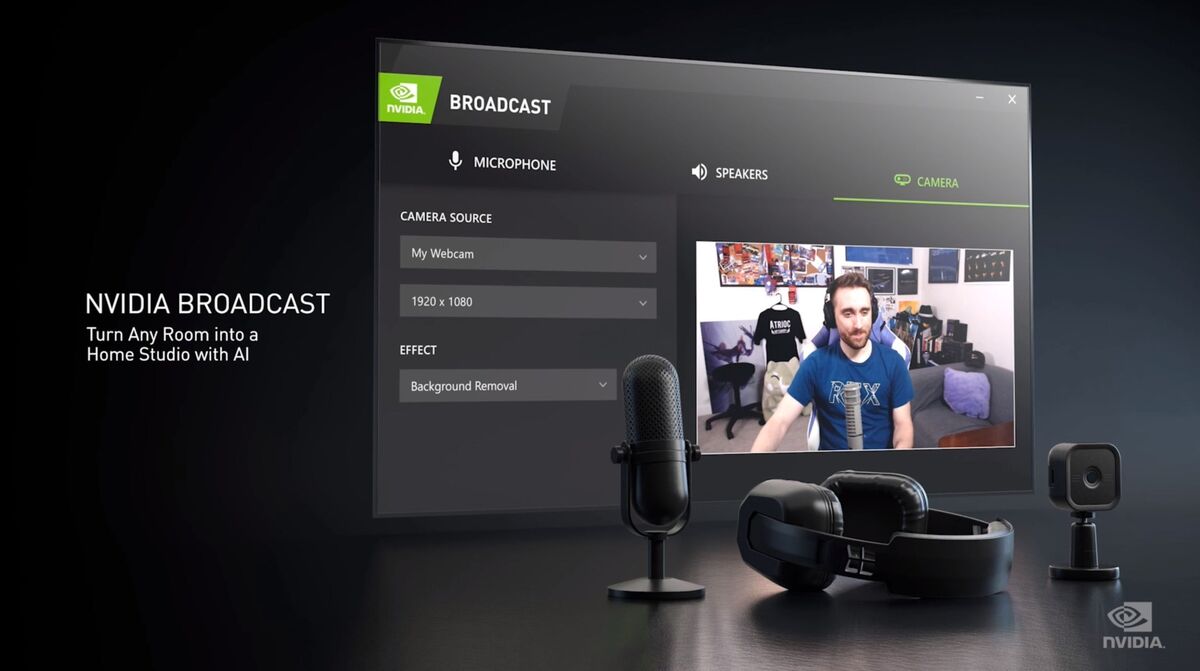 Nvidia
NvidiaFinally, if you’re into streaming, you’ll want to check out the Nvidia Broadcast suite also rolling out this month. It taps into the AI tensor cores inside RTX GPUs to add some professional polish to your streams. The suite includes the magical RTX Video noise-cancellation feature, along with adjustable background blur, greenscreen-style background replacement, and automatic head-tracking effects for your video feed. They looked pretty darn impressive in the demo.
Looking for even more info? Check out our GeForce RTX 30-series announcement coverage and RTX 30-series vs. RTX 20-series spec comparison to wade deep into talk about transistor process nodes, HDMI 2.1 support, and more.

















